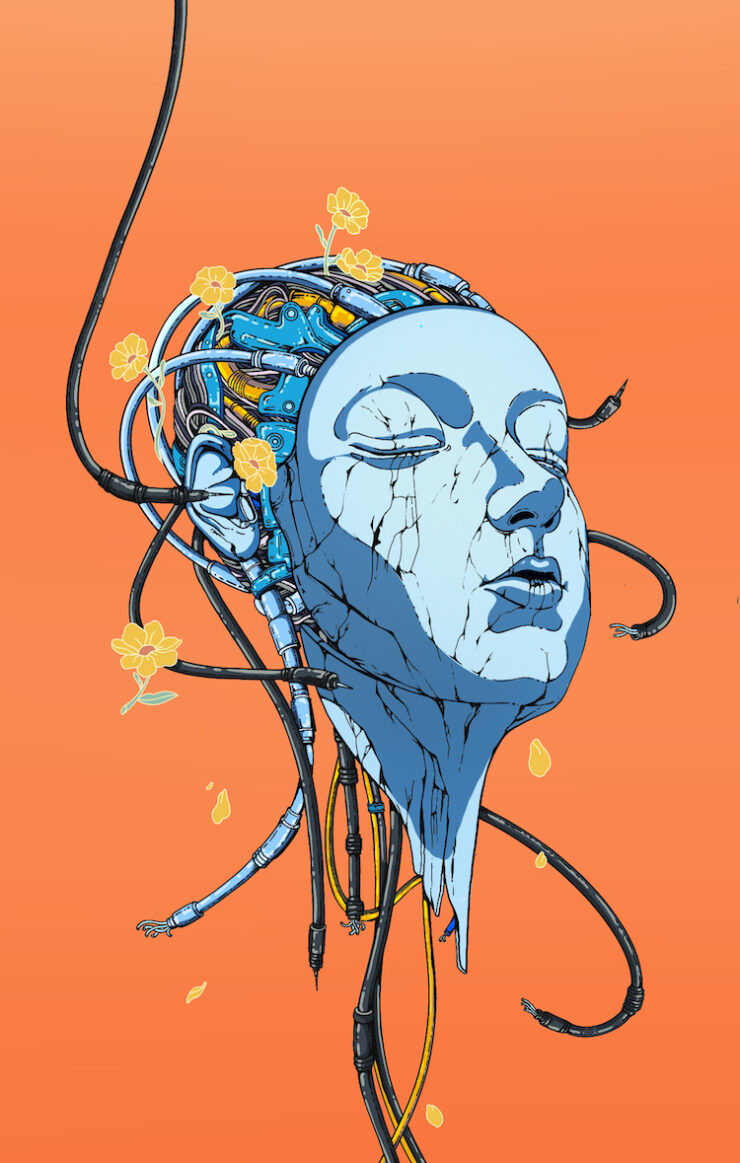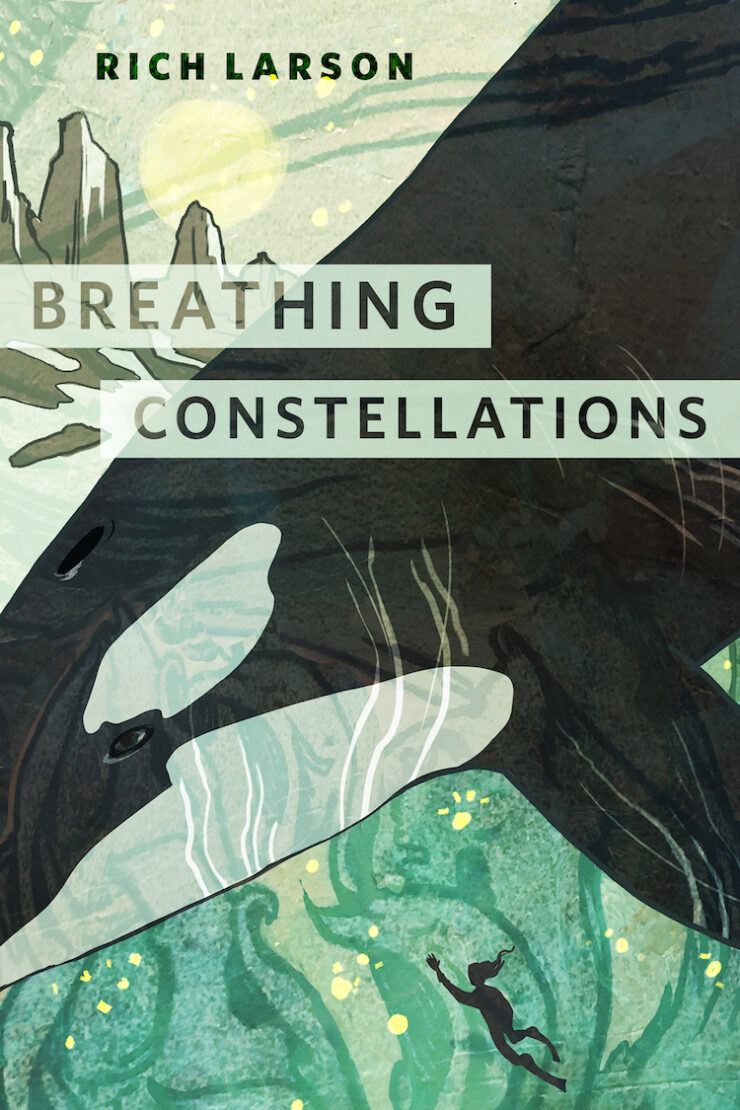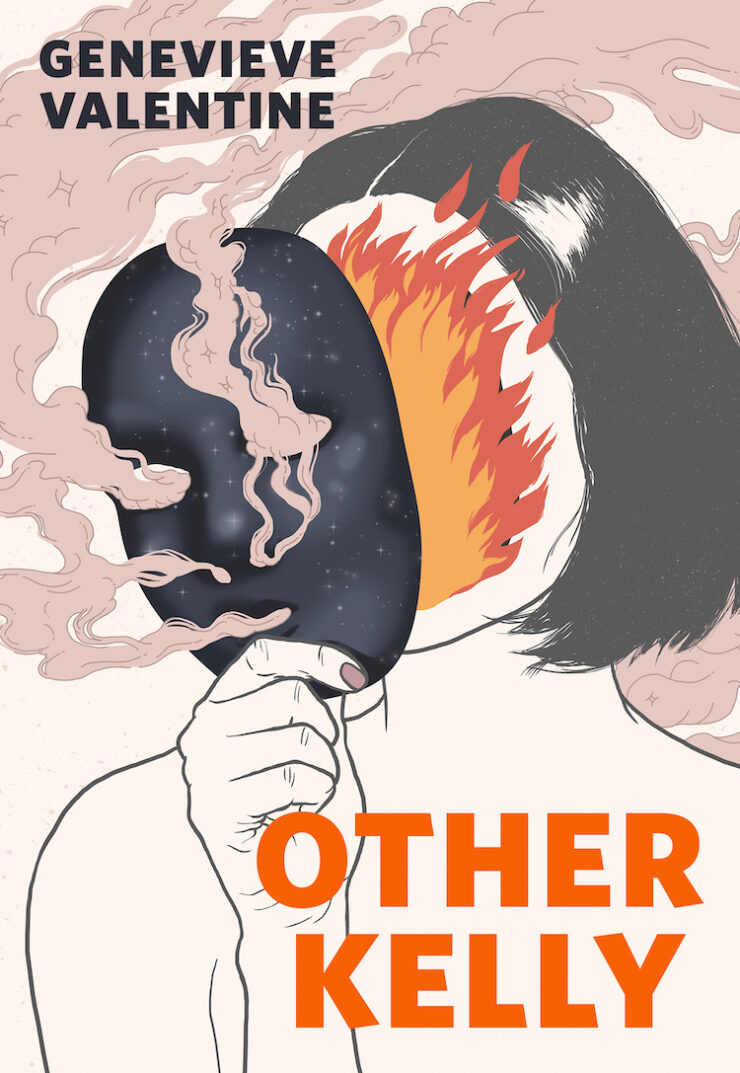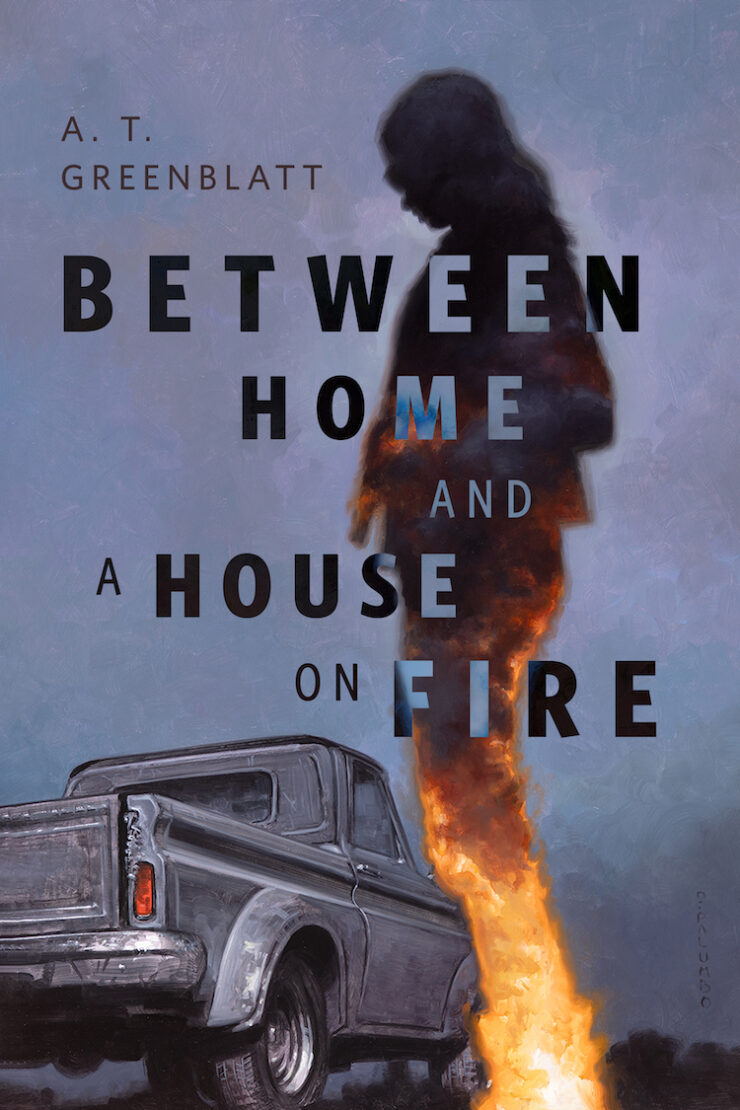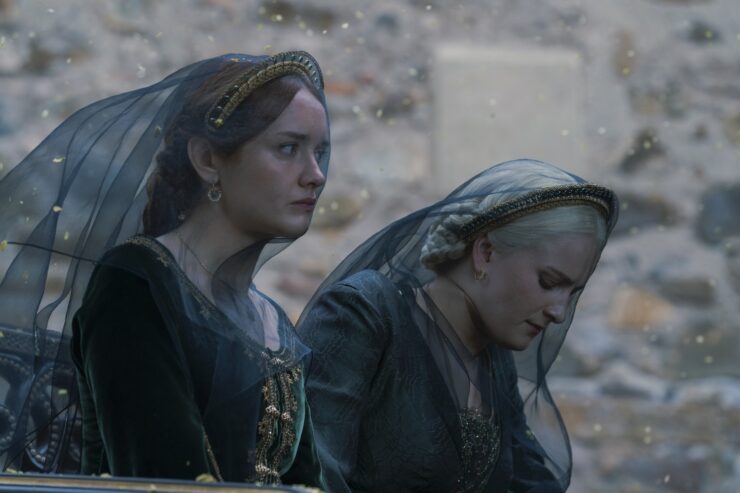Now that the most horrific event in all of Fire & Blood is behind us, episode two is all about the aftermath: the grief that follows tragedy and the ways in which political spin turns personal loss into weapons of war. It features some stella acting from Olivia Cooke and Phia Saban as well as more than one line for Emma D’Arcy! But let’s dive into the episode and discuss both the merits of the show’s adaptation as well as some of the underlying themes being adapted.
The Title
The title, “Rhaenyra the Cruel,” refers to the sobriquet that the funeral procession crier gives her as the body of Prince Jaehaerys is taken through the streets. Given that “the cruel” was the epithet of Maegor and Archmaester Gyldayn, the in-word narrator of Fire & Blood sometimes refers to Rhaenyra as “Maegor with Teats,” this appears to be a slightly less sexist and dismissive version of the appellation. After all, Westeros on screen has (some) more modern sensibilities than the version described in the books and we likely wouldn’t buy that Otto Hightower would give her a name so repugnant to the women of the realm. This nickname (the Cruel/Meagor with Teats) is the one that will stick with her, as the book only obliquely gives us any reason to doubt that she was responsible for the murder of Jaehaerys—a sentiment echoed by her council in episode.
Rhaenyra, of course, does set the murder in motion by saying only “I want Aemond Targaryen” in the whole of last episode. Obviously, the title is meant to be a tragic one; Rhaenyra is attempting to rule with dignity and thoughtful strategy. Her cruelty is not on display in the series so far and she gawks at the Painted Table about why on earth anyone would believe she wanted to hurt Helaena in recompense for her own murdered son. Just as the opening titles substitute the black dress for her white wedding dress on the evening when the terms “black” and “green” were coined, the very episode titles are locking in the unfeeling, sexist, and deeply simplistic gaze of a flawed history that will eventually be reported as fact.
Unraveling the Opening Titles
The opening titles are the same as last week but I have a couple of corrections and new observations about them:
- I’m pretty sure the panel with the kneeling figure depicts them being sacrificed. I mentioned blood magic last week but the positioning of the two makes it clear that it’s the kneeling figure’s blood being spilled. It may even be Nissa Nissa, the wife of the ancient hero, Azor Ahai who killed his beloved wife to temper Lightbringer, the flaming, magical sword that defeated the White Walkers. (Azor Ahai is also the basis for the famous “prince that was promised” prophecy, which holds that he will be reborn to deliver the world from darkness.)
The Azor Ahai myth comes from the ancient, blighted city of Asshai-by-the-Shadow but many cultures across Essos assume that it is an Asshai’i name for a hero from their own culture, including the Valyrian hero Neferion. Incidentally, it’s often theorized (both by fans and in-world) that blood magic experiments–especially those involving dragons–were what caused the Doom of Valyria. Also note that the human-headed dragon she kneels before is probably representative of Valyrian sphinxes (who, as depicted in in-world art, have dragon bodies and human heads) and likely represent the magical bond between dragon and dragonrider.
- You can see Dragonstone lightly stitched behind Daenys the Dreamer in her panel. That probably makes the dead figure in her arms Aenar Targaryen, her father who left his seat of power in Old Valyria to stay at Dragonstone instead.
- In the panel that I referred to as the burning of Harrenhal last week, we actually see two historical events at once. Harrenhal is depicted at the top, but the dead bodies below, between the jaws of the Balerion and Vhagar, have the lion heraldry of House Lannister and the green hand heraldry of House Gardener. This means that the lower part of the panel depicts the Field of Fire where Aegon the Conqueror and his sister-wife Visenya, on dragonback, destroyed the armies of the Lannister and Gardener Kings, killing King Mern IX Gardener and forcing King Loren I Lannister to bend the knee.
- Similarly, the panel depicting Torrhen Stark, the King who Knelt, peacefully submitting to Aegon, also shows Edmyn Tully, Lord of Riverrun and Sharra Arryn, the Queen Mother of the boy-king Ronnel Arryn, similarly kneeling. In this way, the panel is the complement of the previous one. That showed the destruction of the Kings and Lords who famously refused to submit—Lannister, Hoare, and Gardener—whereas this shows the ones whose legacies were defined by choosing to ally with the Targaryens rather than fight them. Also of note in this particular grouping is that the three Houses that knelt—Stark, Arryn, and Tully—are three of the important Houses in what fans have dubbed “the grand Northern conspiracy” whereby the generation immediately before the start of the 1996 novel, A Game of Thrones, chose to intermarry (Catelyn Tully was betrothed to Brandon Stark and wed Ned after Brandon was killed, Lysa Tully wed Jon Arryn, and Jon Arryn fostered Ned alongside Robert Baratheon who was engaged to Lyanna Stark), potentially in order to form a block of lords powerful enough to challenge the increasingly unstable Targaryen Kings. There is extra weight put behind their challenge as the Baratheons are descended from Aegon the Conqueror’s bastard brother, Orys, and the Tullys, Starks, and Arryns were all among the most powerful of the Targaryen’s allies from the start.
- Next to the dead Maegor on his throne are the heads of the dragons of his successors—Vermithor and Silverwing—the dragons of Jaehaerys the Conciliator and Good Queen Alysanne respectively. Both dragons are still alive in 127 AC (when HotD takes place) but have no riders. We actually saw Vermithor last season when Daemon descended into the volcanic tunnels underneath Dragonstone and sang that Valyrian lullaby to that massive creature. Vermithor (who, I mentioned in my coverage last season, is named for Vermithrax Pejorative–the dragon from the 1981 film Dragonslayer) is the second largest and second oldest living dragon after Vhagar.
- As the necks of their dragons pan down to reveal Jaehaerys and Alysanne themselves, we see the seven-pointed star of the Faith of the Seven since it was that royal couple that officially buried the hatchet and brokered a peace between the leaders of the dominant Andal faith and the Targaryen family, who had traditionally kept the Old Valyrian gods and practiced incest (forbidden by the Seven).
- Around the panel depicting Aegon II and Rhaenyra’s coronations, there are color-coded hands distributing ravens for the greens and dragons for the blacks—note that Aegon will criticize Otto Hightower for being too dependent on diplomacy (symbolized by ravens or ink) in this episode and that Rhaenyra sends her dragonriding children as envoys. There are also shields around the border of each court symbolizing their strongest allies. The Greens have (I think): House Stokeworth (a lamb holding a goblet), House Tyrell (a golden rose), House Cole (ten black pellets), House Baratheon (a currently uncrowned stag), House Hightower (the titular Hightower with green flames atop it), House Lannister (a lion), House Fossoway (an apple), and House Wylde (a spiral pattern); it’s possible one of the sigils is House Strong (a red, green, and blue river). On the black side we have: House Bar Emmon (a swordfish), House Beesbury (bees and hives with yellow and black stripes), House Tully (a trout against a red and blue river), House Velaryon (a seahorse), House Arryn (a moon and eagle), House Stark (a direwolf), and House Yronwood (a closed portcullis); it’s possible that the other two sigils are House Caswell (a centaur) and House Frey (two towers connected by a bridge).
The Madness of Queen Helaena
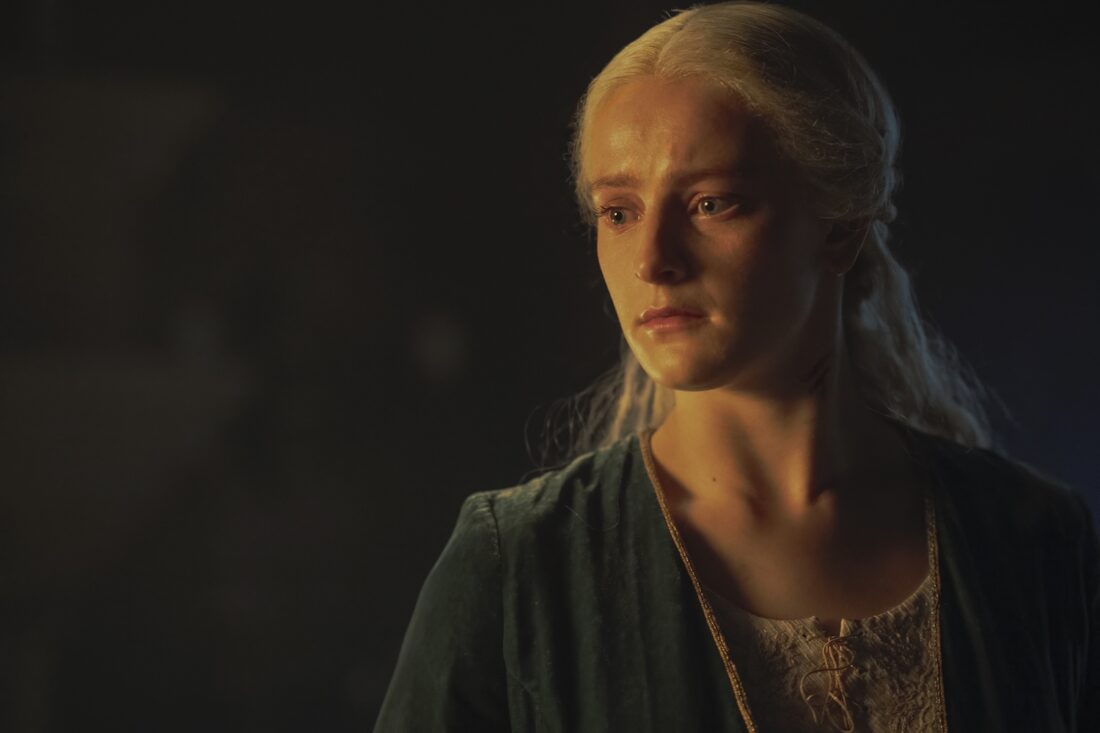
There are a number of tired tropes that writers ought to avoid or, at the very least, be conscious of when crafting a narrative: “bury your gays,” “the Black character dies first,” etc. Among them is the conflation of mental illness and superpowers. It’s not a new phenomenon. Conan Doyle’s Sherlock Holmes stories have been as a representation of a person with a variety of mental illnesses and disorders, and no matter what the diagnosis, in the text, his symptoms and behavior are seen as the source of his brilliant deductive skills–they fuel his special abilities.
Now, I need to put on my literature professor pipe and smoking jacket for a moment here and make the general caveat that, as a reader, it is generally considered a problem to diagnose fictional characters with real world disorders, conditions, and illnesses. After all, fictional characters don’t have an unconscious or a psyche apart from their author so they can’t be psychoanalyzed. Furthermore, authors do have an unconscious and their own writing is subject to their preconceptions, misinformation, and sublimated desires. Conan Doyle writes that cocaine helps calm Sherlock Holmes down and a modern reader might say “Aha! He must have some form of ADHD because of the brain chemistry.” But Conan Doyle, even as a physician, had an imperfect understanding of medicine (as do we) and Holmes only exists as a creation of his potentially misinformed creator. All this is to say, Helaena and Alicent have been written in a way that suggests, to me, that the writers, directors, and actors involved believe them to have some form of neurodiversity and/or mental illness that they are attempting to write towards with a modicum verisimilitude. As I talk about their characterization and behaviors below, I’ll use the names of conditions as a shorthand for what I think the writers are up to, but know that (a) I can’t diagnose them with any accuracy as I’m not a trained psychiatrist, and (b) no one can ever diagnose any fictional character.
Queen Helaena (Phia Saban) is coded as autistic on the show and she is also prone to the prophetic dragon dreams and visions that some Targaryens experience. Last season, she proclaimed that Aemond would “need to close an eye” in order to claim a dragon—Aemond is then maimed by Lucerys immediately after bonding with Vhagar (S01E05). She plays with a spider, chanting “hand turns loom; spool of green, spool of black; dragons of flesh weaving dragons of thread” prefiguring the formation of the rival factions (S01E07). She cryptically warns “beware the beast beneath the boards,” which many book readers assumed referred to the Blood and Cheese episode but which turned out to be in reference to Rhaenys and Meleys bursting from the floor of the Dragonpit during Aegon’s coronation (S01E08). And last episode, she does offer a cryptic warning about Blood and Cheese and the coming attack, telling Aegon she isn’t afraid of “the dragons, [but] the rats” (S02E01).
Any portrayal of otherness that categorizes that difference as special and even as an uncomplicated positive is potentially harmful as it obfuscates the real, lived experience of the non-fictional people being portrayed on screen. It can also essentialize a marginalized group as having a life centered entirely around what makes them other or different. The key to getting this right, something I think the show is better at than not, is making sure that there is no intrinsic link between difference and advantage. In this case, is Helaena prophetic because she is autistic or is she simply both?
Fire & Blood’s initial characterization of Helaena is that she is “a pleasant, happy girl” (Fire & Blood 386). Later, after the horrific Blood and Cheese incident, Martin/Gyldayn says she “cannot be said to have survived that fateful dusk […] Queen Helaena sank deeper and deeper into madness” (Fire & Blood 426). We get a bit more about her as the narrative progresses, some of which may be represented on the show, but it is clear that Helaena’s unspecified madness is, likely, mostly the result of her intense grief and trauma. While she rides the blue dragon, Dreamfyre, the book has nothing to say on whether or not she has dragon dreams. So this whole issue is really an invention of the show.
After the rushed pivot from greatness to madness that Benioff and Weiss inflicted on Daenerys (Emilia Clarke) in the final two episodes of GoT, the choice to show women in power as unstable or unhinged is certainly a fraught one. And, in a recent LA Times article Olivia Cooke highlights the fact that, in Gyldayn’s account of the Dance of the Dragons “women are ellipses in […] Martin’s book” saying “Women are always omitted in the annals of history […] it’s really potent, that absence.” So it can be a recipe for something truly awful to double down on the intentional misogyny of Gyldayn’s focus (or erasure) by filling in those gaps with portrayals that echo the same toxic accusations leveled at so many women in leadership positions.
But the show does, at least, seem to be taking Helaena’s autism coding somewhat seriously, attempting to represent her experiences with it and giving her moments of suffering as a result of being different from her family that are not linked to her dragon dreams. The sequence where she and Alicent (Olivia Cooke) ride through King’s Landing for Prince Jaehaerys’ funeral procession showcases her overstimulation at being greeted by grief-stricken lowborn mourners. We are so used, as viewers, to noble jaunts through King’s Landing ending in mob violence—the food riot in GoT season 2, Cersei’s walk of shame in GoT season 5—that director Claire Kilner is able to draw on the audience’s expectations to ramp up our unease, making the anguished cries of grieving, smallfolk mothers feel sinister and oppressive as Helaena’s agoraphobia kicks in.
And it’s not just Helaena. Alicent is implied to have some species of obsessive-compulsive disorder: with her constant picking at her skin (all the close-up shots of her this episode show her hangnails and scratches), her despondent bathing, and even her religious scrupulousness. The magical thinking on display as she blames herself for Jaehaerys’ death does feel true to form as it relates to, at the very least, my personal experience of OCD. There is, of course, the potential that the bathing and scrubbing are some sort of allusion to Lady Macbeth, but it does seem like whatever thematic purpose her mental health issues are put to, Alicent’s struggles are also being used to highlight her anxiety in a way that doesn’t feel particularly irresponsible. It’s a thorny issue and one that bears scrutiny as the series progresses but it does seem like Ryan Condal and his writers’ room are paying attention to the potential pitfalls of these tropes and characterizations and learning from the mistakes of their predecessors.
An Emphasis on the Smallfolk
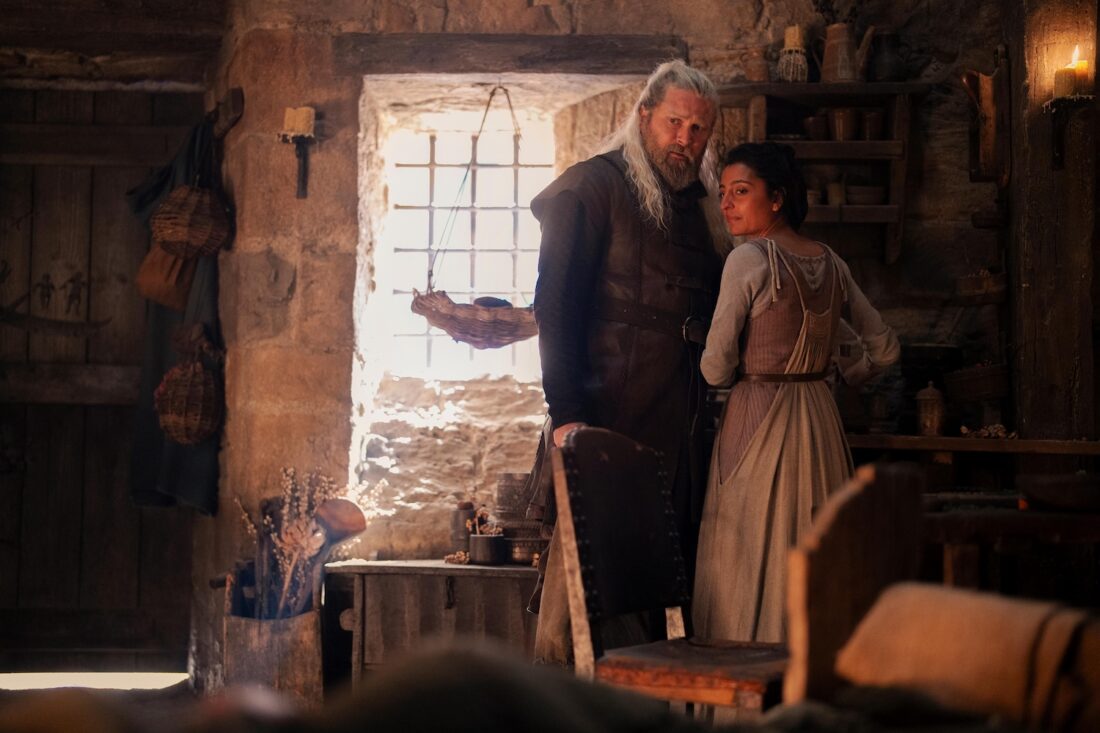
In the first episode we got a scene where a blacksmith, Hugh “Hammer” (Kieran Bew), petitions the king for promised money upfront. This episode we see him and his wife fret over his sick daughter. We also had a scene, last episode, between Corlys Velaryon (Steve Toussaint) and the Helmsman Alyn of Hull (Raised by Wolves and Assassin’s Creed: Origins’ Abubakar Selim), who fished the gravely injured Lord of the Tides from sea. Now we are introduced to Alyn’s brother, Addam (Clinton Liberty), a shipwright. We even get our first look at Ulf the White (Tom Bennett)—he’s the well-dressed commoner asking about the hanged ratcatchers.
All four of these characters are important members of the smallfolk in Fire & Blood, and the show is wise to introduce them and give them a little background before the moment when they become significant to the main plot. Archmaester Gyldayn’s narrative doesn’t have much use for the smallfolk until they become essential to the telling of the tale and, writing at the remove of more than a century from the events, information on ordinary, lowborn (often poor) people is presented by the fictional narrator as scarce and potentially apocryphal. As I wrote in last week’s explainer, we don’t even get the names of the murderers of Prince Jaehaerys; they are only ever called Blood and Cheese.
Blood and Cheese themselves are killed off this episode, and the death of the latter helps to illustrate a growing theme of this show. It’s actually articulated, in episode, by Michelle Bonnard who plays Sylvi, the madame and sex worker that Aemond (Ewan Mitchell) is so attached to. When Aemond admits that his loss of temper is what led to Lucerys’ death, she responds “when princes lose their temper, ‘tis often others who suffer—the smallfolk, like me.” We see the truth of those words over and over again in this episode. It opens with the frenzied rounding up of castle staff, the second such shakeup among them after the premiere confirmed that Larys Strong has already had many of them questioned, tortured, and killed. Aegon’s mass killing of the ratcatchers is the direct result of his anger. The Madam is right, the smallfolk always suffer in the game of thrones. Elsewhere, Helaena tells her mother that part of her reaction to the mothers at the funeral procession was partly a fear of unworthiness—that the mothers of the smallfolk lose their children more often. Helaena’s empathy is precisely what Gyldayn lacks, in his depiction of events throughout the book.
There is, of course, one member of the smallfolk that Gyldayn speaks about at length, albeit in almost entirely negative terms—Mysaria (Ex Machina and Maniac’s Sonoya Mizuno), also known as “Lady Misery” and “the White Worm.” Last episode we found her literally adrift, fleeing King’s Landing as a stowaway after Larys Strong and Otto Hightower had her brothel burnt to the ground. This episode, she and Rhaenyra commiserate as two women spurned by Daemon, but they are not equals. Mysaria may have risen high from her childhood as a slave, but her wealth and status have always been predicated on the whims of her highborn lovers and employers. Otto Hightower burned down her home and business when her intellect proved more threatening than useful and Daemon left her rotting in a dungeon without fulfilling his end of the promised bargain: “Might as well have remained a whore,” she tells her captor. When Rhaenyra asks her how she got the scar on her neck, it seems as though the Queen thinks it might have been given to her by Daemon. We don’t know how she got it, but the possibility of it being the result of a slave collar, a punishment from someone who caught her stealing, or an abusive client’s revenge from her days as a sex worker seems likely–more likely than Daemon’s hand. Rhaenyra, in asking, betrays Gyldayn’s sensibilities—that the smallfolk are only injured when they get in the way of their betters.
The Green Council
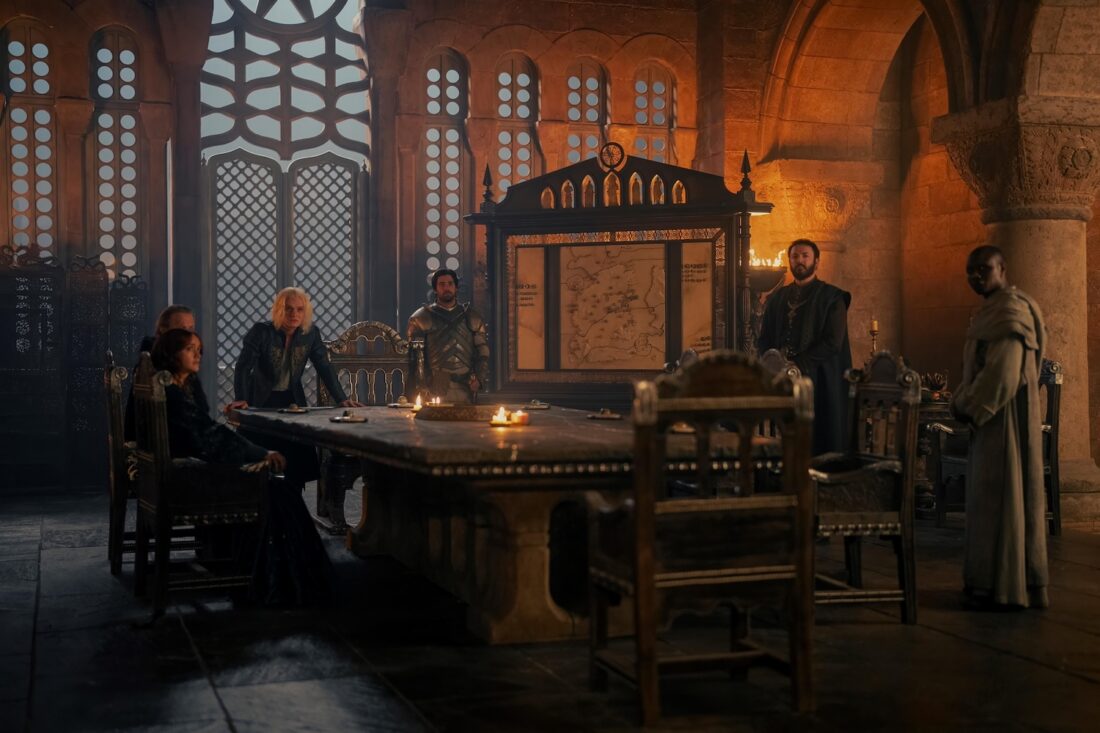
Episode 2 gives us some major changes in terms of who is supporting and advising King Aegon II, so it may be time to review the members of his small council.
Ser Otto Hightower — Hopefully you have all been following Rhys Ifans’ excellent portrayal of Alicent’s father, who is sacked from his long-term position as Hand of the King this episode. He’s a well-regarded statesman and the younger brother of Hobert Hightower, the Lord of Oldtown. Otto served as Hand under King Jaehaerys, King Viserys, and now King Aegon II. It’s actually the second time he’s been fired, having been let go by Viserys in episode 5 of season 1. His track record is looking increasingly bleak.
Ser Criston Cole — Newly promoted to Hand of the King, Criston Cole (Fabien Frankel) also serves as Lord Commander of the Kingsguard after Ser Harold Westerling (Graham McTavish) resigned last season. He’s easy to hate, being a petty, “nice-guy” misogynist whose allegiance to the Greens stems from his bitterness towards his former lover, Rhaenyra. He also murdered Joffrey Lonmouth (Solly McLeod) for daring to suggest that Rhaenyra was important to him. In the books, House Cole is a minor family from the Reach, but the show has explained that he is Dornish. Dornishmen are an exoticized other in Martin’s text and there’s perhaps some small modicum of sympathy that can be had for a man who rose up from near-nothing and is constantly used as a pawn by the royal family (even if some of those royals may not have malicious intentions).
Ser Tyland Lannister — Jefferson Hall (Taboo, Oppenheimer) plays both the long-suffering Ser Tyland Lannister and his twin brother, Lord Jason Lannister (who gets a name drop in this episode and appeared as a frustrated suitor to Rhaenyra in season 1). Last season he was King Viserys’ Master of Ships, filling in for the first wounded, then traitorous Corlys Velaryon. Now he serves as Master of Coin, taking over for Lyman Beesbury who was accidentally killed by Criston Cole in S01E09. Obviously, Ser Tyland is a Lannister and their deep pockets stem from the gold-laden hills of the Westerlands where they serve as High Lords and Wardens of the West.
Lord Jasper Wylde — Called the “Ironrod” and played by The Frankenstein Chronicles’ Paul Kennedy, Jasper Wylde has served as Master of Laws ever since the position was vacated by Lyonel Strong when he was briefly promoted to Hand of the King in S01E06. Gyldayn suggests that his nickname is either a reference for his reputation as a martinet or a dirty joke about his many bastard children. House Wylde holds their seat at Rain House in the Stormlands. Now that Borros Baratheon has declared for the Greens, Lord Jasper no longer has any conflict between serving the crown and serving his High Lord.
Grand Maester Orwyle — Played by Kurt Egyiawan, he is a Maester of the Citadel, Westeros’ celibate and House-name-forsaking order of physicians, scientists, and historians. Every royal small council traditionally has a seat for a Grand Maester. They are not to be confused with the Archmaesters (like Gyldayn) who actually run Oldtown’s Citadel where Maesters are trained. Jim Broadbent played the cruel Archmaester Ebrose on GoT when Samwell Tarly (John Bradley) went to train there. Orwyle served as an apprentice under the previous Grand Maester, Mellos (played David Horovitch in season 1). The show has attempted to portray Orwyle as somewhat more innovative than his predecessor, having attempted to dissuade Mellos from continuing to leech the ailing King Viserys.
Lord Larys Strong — Mocked as “Clubfoot,” Lord Larys (Matthew Needham) is not an official member of the small council, but he serves as a sort of de facto Master of Whispers (the capacity in which both Conleth Hill’s Lord Varys and Anton Lesser’s Qyburn served during the original series). He is the son of the deceased Lord Lyonel Strong (Gavin Spokes) who served as Master of Laws and eventually as Hand of the King under Viserys I, and the younger brother of Ser Harwin Strong (Ryan Corr), a master-at-arms who secretly fathered Rhaenyra’s three eldest children. The Strongs currently rule Harrenhal, and Larys ascended to Lordship after having his father and brother killed in a fire last season. Last season, there was some speculation that he was a shapeshifting warg (like Bran Stark) among fans who believed that he used his powers to inhabit the rats of King’s Landing and seek out information. That’s probably not true. Probably.
Unreliable Narrators: Ser Erryk and Ser Arryk
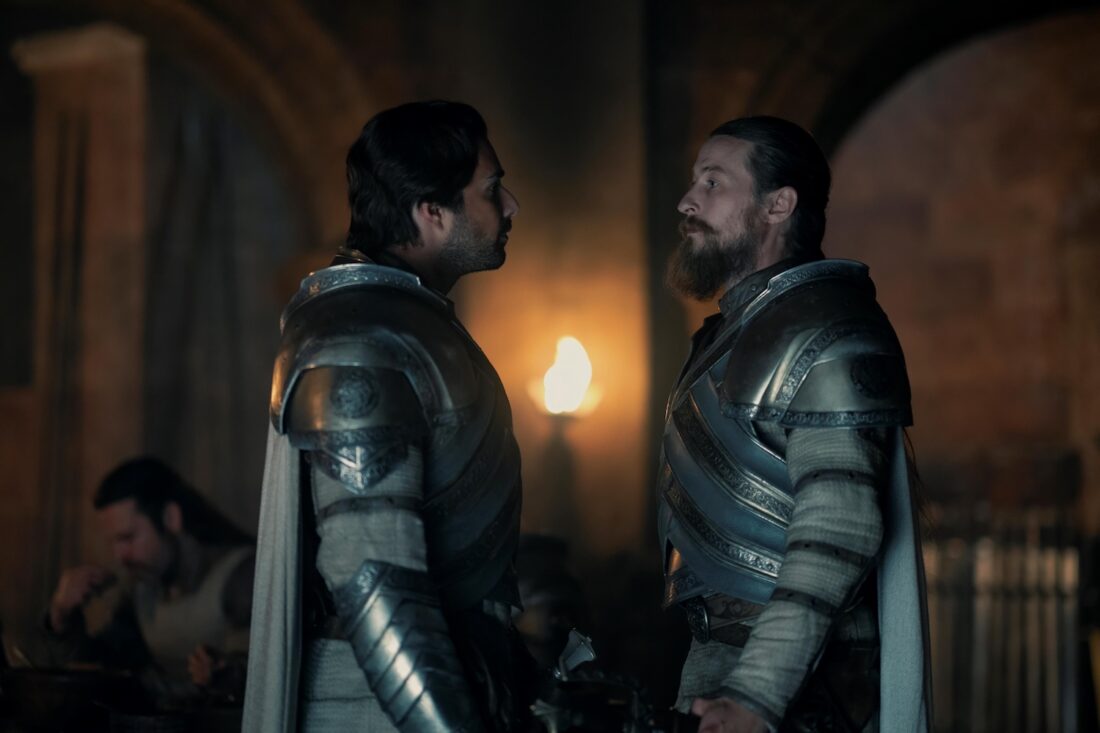
Both the premiere and this episode reach uneasy crescendos with tense scenes of overwhelmed would-be murderers wandering through unfamiliar castles, the danger of discovery at every turn. Both murder plots are the result of impulsive schemes set in motion by people desperate to take action. It’s actually pretty funny to have Otto call out Ser Criston’s assassination plot as ludicrous, given that Archmaester Gyldayn recounts the tale with no hint of skepticism about its merits. But, like many events on House of the Dragon, the equivalent moment in Fire & Blood is told through unreliable narrators.
In this case, Archmaester Gyldayn gives us two accounts. The first, by Grand Maester Munkun— Orwyle’s apprentice who professes that his account comes from his master’s notes—claims that “the singers tell us that Ser Erryk said, ‘I love you brother,’ as he unsheathed his blade, and that Ser Arryk replied, ‘And I you, brother,’ as he drew his own. […] The twins battled for the best part of an hour […] but the onlookers could only stand by helplessly and watch, for no man could tell which brother was which. In the end, Ser Arryk and Erryk dealt each other mortal wounds, and died in one another’s arms with tears upon their cheeks” (Fire & Blood 432).
The second account is from Mushroom, Rhaenyra’s wise, if irreverent, court Fool. According to Gyldayn, Mushroom says that “the fight lasted only moments […] There were no declarations of brotherly love; each Cargyll denounced the other as traitor as they clashed […] Ser Erryk […] took his brother’s sword arm off at the shoulder, but as he collapsed, Ser Arryk […] pulled him close enough to drive a dagger into his belly […] Erryk took four days to die of his gut wound, screaming in horrible pain and cursing his traitor brother all the while” (Fire & Blood 432).
As in most other cases, the show walks a nuanced middle path. See Arryk, upon successfully making it all the way to Rhaenyra’s room, does declare his love for this twin before engaging him. There are elements of Munkun’s clearly romanticized account with the genuine grief of both brothers on display. But Mushroom has the right of it with the fight being relatively short and brutal. We also get a completely new ending to the fight where Ser Erryk triumphs over his murderous brother but, despondent over the death of his twin, chooses to take his own life, quite literally falling on his sword with a shouted “forgive me” to Rhaenyra.
As I said above, it’s an echo of last week’s murder of Prince Jaehaerys—a pointless and tragic death spurred on by an ill-thought-out plan. The Cargyll twins may not be smallfolk, but their brotherly love has been divided and tossed aside by the whims of the royals they serve. Obviously, Rhaenyra and Alicent themselves are not directly responsible for the deaths of their respective Kingsguard knights, but there is, increasingly, no going back and no set of clean hands remaining, going forward. When what is asked of one’s servant means they would rather end their own life than continue with their service, the system is, clearly, already profoundly broken.
Odds and Ends
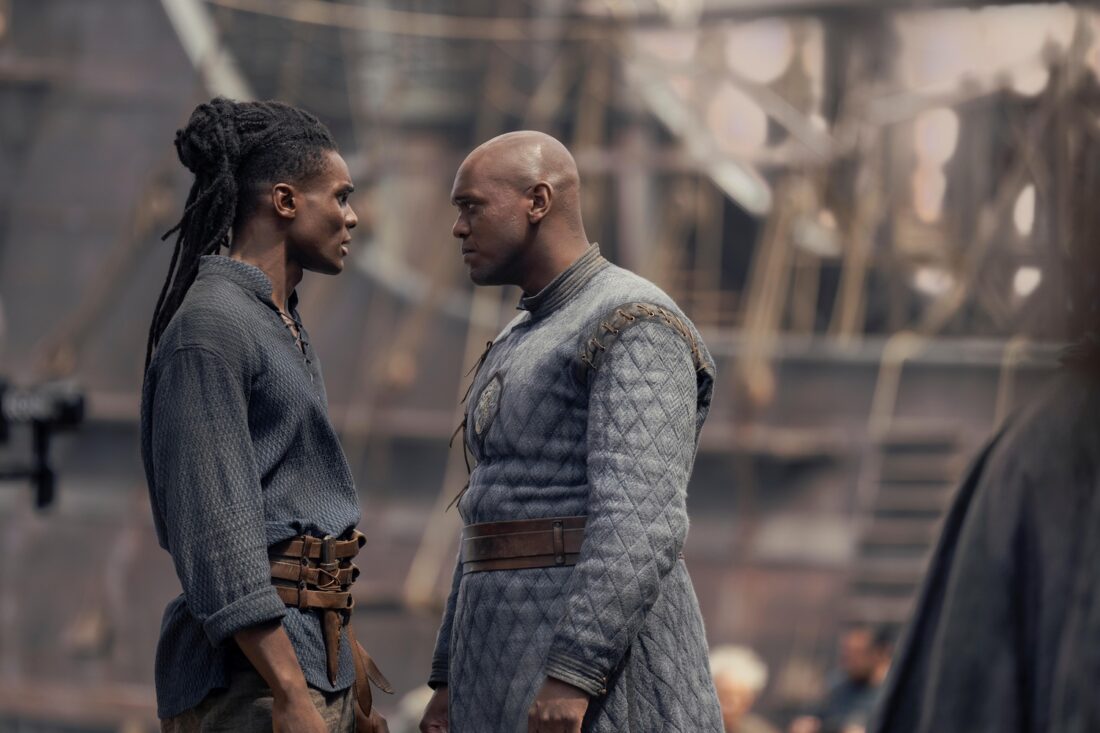
- Daemon’s barely-constrained rage during his confrontation with Rhaenyra is some great staging. The ASoIaF franchise doesn’t lack for male chauvinist monsters but I love that his violent outbursts are played for real nuance. Part of having a slightly safer, more thoughtful writers’ room means that you can get away with shades of gray among your monstrous characters. Because Daemon is so irredeemably awful, the audience can get into the weeds of occasionally empathizing at specific moments without fear that the show is attempting to redeem him. That gesture to choke Rhaenyra before cupping her face in his hand is chilling and uncomfortable and also incredibly engaging. You couldn’t have pulled it off in the original show because the original show gave us precious few reasons to trust their vision.
- Prince Jacaerys (Harry Collett) and Baela (Bethany Antonia) discuss Jace’s two father figures—Laenor, his acknowledged father, and Ser Harwin, his actual, biological father. I love that the show is digging into the idea that Jace vaguely but imperfectly understands his own bastardy. In saying that Ser Harwin, he thinks, loved him, he is opening the door to acknowledging that he is not a Velaryon. Baela’s reply that “of course he did” gives us some insight into the fact that at least some in the Black court think Rhaenyra’s protestations are entirely a lie. It will be interesting to see how these dynamics play out going forward.
- The little person cup-bearer that works in Sylvi’s brothel pours Aemond a cup of hot milk. Glad to welcome him to the confederacy of milk-drinking psychopaths.
- Corlys Velaryon (Steve Toussaint) implying that Rhaenys (Eve Best) is the top in their relationship is both hilarious and strikes me as deeply accurate.
- Lots of folks have complained about Mysaria’s accent. Sonoya Mizuno was raised in England and seems to have a light London accent in interviews. She’s given Mysaria a vaguely French, mostly generic continental accent. She’s from the Free City of Lys in Fire & Blood, an ex-Valyrian colony and one of three city-states of the Triarchy, famed for its brothels and poisoners. The only other Lysene character we’ve seen in a Game of Thrones show is Salladhor Saan (Lucian Msamati), Davos Seaworth’s pirate buddy. Msamati used something akin to his Tanzanian/Zimbabwean accent playing the role. In general, I’m a fan of there being different regional accents for characters from Essos though, I will admit it’s odd to have Mysaria be the only one doing it, especially when other folks from the Free Cities like Prince Reggio Haratis of Pentos (Dean Nolan) just using a standard RP British accent.
- The library at Dragonstone looks out at a dragon skull mounted on a dais. It probably belongs to Meraxes, the third of Aegon the Conqueror’s three dragons. This is the one ridden by his beloved sister-wife, Rhaenys, and both dragon and rider were killed in Aegon’s hubristic attempt to conquer Dorne.
- Addam sees Seasmoke, Laenor Velaryon’s dragon. Last season, some book-reading fans were unhappy with Laenor surviving what, in the books, is his actual death because it would mean that his dragon would still be bonded with him and continue to stay by his side. In the books Seasmoke has gone feral after the death of Laenor and while the dragon still has a part to play, we understand that he is something of a liability, unbonded to a rider. I assume the show is simply making Laenor’s exile in the Free Cities into enough of a distance that Seasmoke is unbonded. It’s imperfect, but it’s still better that Laenor is alive (see my comments on burying one’s gays, above).
- Cheese’s mangy dog staring up at his hanged corpse is among the most pathetic (as in worthy of pathos) images any Game of Thrones series has produced. #justiceforCheesedog
- “I wish to spill blood, not ink” is as close as we get to a 1:1 line from Fire & Blood where Archmaester Gyldayn tells us “Septon Eustace tells us of one occasion when Aegon entered the Tower of the Hand and found Ser Otto writing another letter, whereupon he knocked the ink pot into his grandsire’s lap, declaring, ‘Thrones are won with swords, not quills. Spill blood, not ink’” (Fire & Blood 428).
- Rhaenyra’s maid, Elinda (Jordon Stevens) wears a device with three spirals meaning that she’s likely a daughter of House Massey, one of the closest families to the Targaryens geographically and in terms of loyalty.
- Daeron Targaryen, Alicent’s fourth child who many had assumed was cut from show gets mentioned this episode. In F&B, he’s the same age as Jace and they were given the same wetnurse in an effort to mend the family divide between Rhaenyra and Alicent. He has been in Oldtown since he was very young, being raised by his second cousin, Ormund Hightower (Otto’s nephew, the son of the apparently deceased Lord Hobert, played by Steffan Rhodri in season 1). Daeron probably won’t show up this season, but it’s good to know that he’s out there for Season 3.
- Alicent saying that she has sinned only to have Otto reply that he does “not wish to hear of it” feels like another incredibly tragic miscommunication. His smile seems to imply that he thinks he is sparing his daughter the pain of confessing what he assumes is a minor transgression (to be fair, it really is), absolving her in the process. But Alicent, so convinced of her own wretchedness and unworthiness, must read it as yet another of her father’s dismissals.
- I’m not going to defend Alicent and Criston’s affair. Obviously, Criston is pretty awful and Alicent is deeply blinded by her guilt in a way that isn’t incredibly sympathetic. But I appreciate the way that the show depicts Criston’s attachment to her as rooted in his fear of being spurned (again), and the simple fact that she allows him to stay by her side. When she slaps him at the end of the episode, there is a pregnant pause where you can see the gears turning in the soiled knight’s head as though he is anticipating her rejection. When it doesn’t come, you sort of can’t help but feel for him–cleaving to the only person who stayed with him despite his many, many flaws.
In Summary
Episode two is 69 (nice) minutes long and relatively quiet, at least compared to the harrowing events of the season premiere. That said, it’s utterly packed with plot, character development, and the absolutely gorgeous production design that both series have always excelled at. Cutting down the episode order by two this season seems to have paid off in terms of both decor and VFX—we’re seeing a lot more of the dragons in these first two episodes, even in idle moments where the show might have chosen to nix them for budgetary reasons.
But what did you think? Did the end of the Brothers Cargyll leave you wanting more or did you see it as a fitting send off? Are you enjoying the new characters this season has introduced? Are you as uneasily on board for #Cristalicent as I am? Just kidding about that last one. I’m not on board. Unless…?


